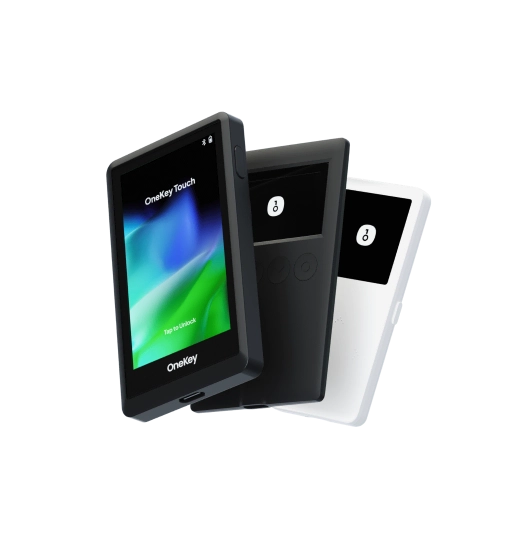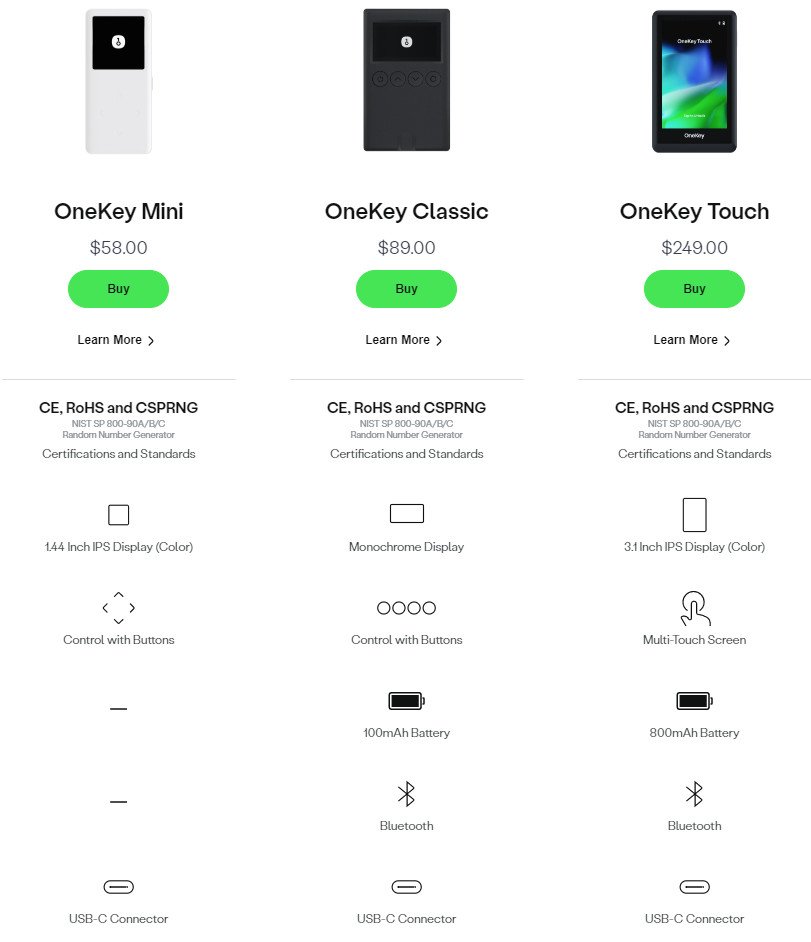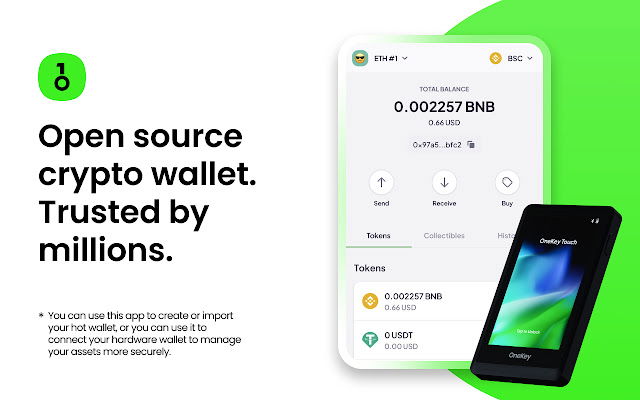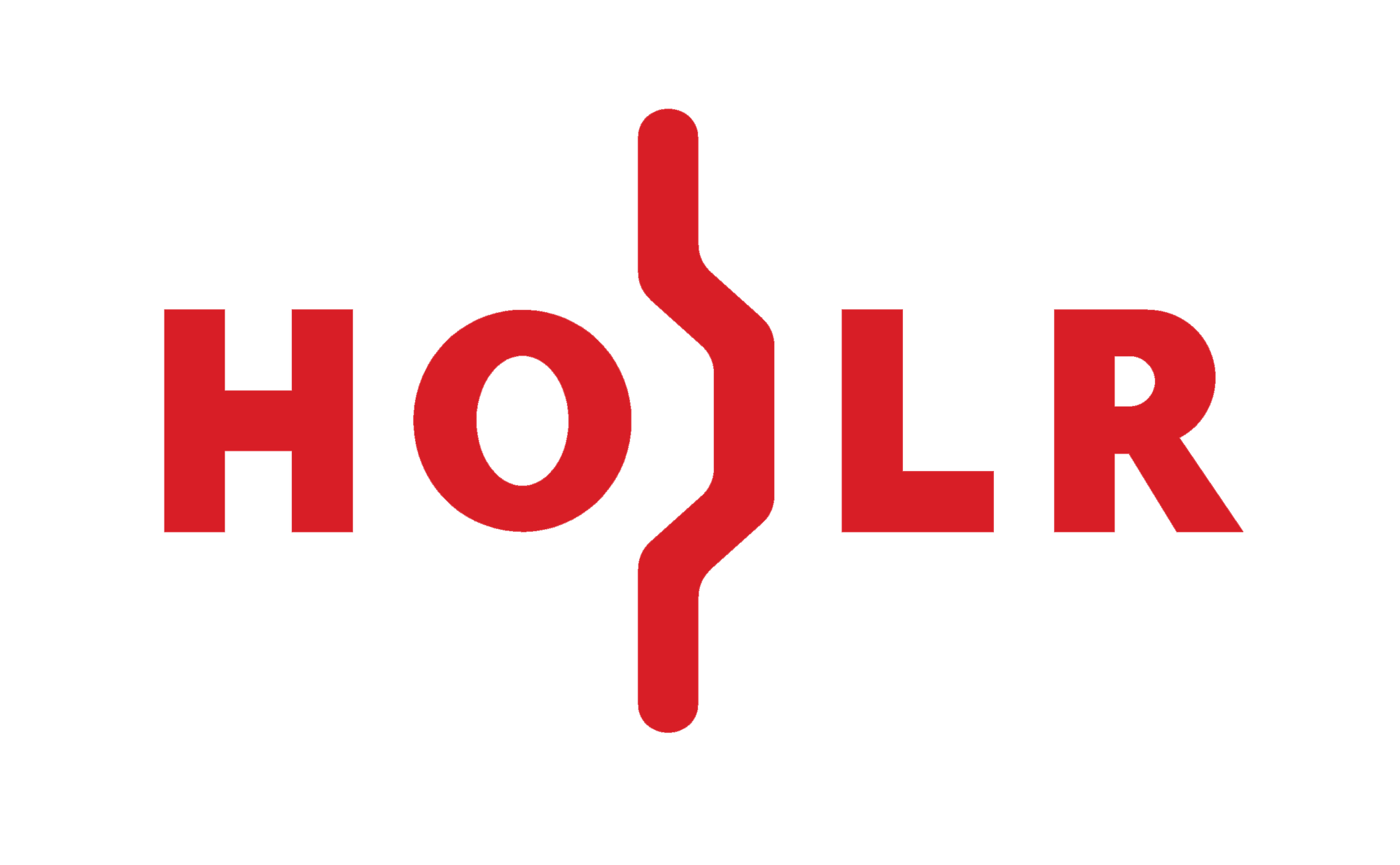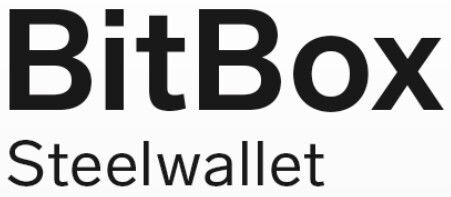Kaspa On Hardware: Development Phase. OneKey x Kaspa Crypto Hardware Wallet, OneKey Limited

Kaspa keys secure and offline with a hardware wallet.

Not Your Keys, Not Your Kaspa
When investing in cryptocurrencies, one of the most important considerations for investors is the security of their digital assets. While software wallets can be convenient, they are susceptible to hacks and cyberattacks. That’s why more and more investors are turning to hardware wallets, such as Ledger, Tangem, and OneKey, for secure storage of their digital assets. In addition, these three hardware wallet options are currently in the development phase to support Kaspa, making them a promising choice for Kas holders prioritizing security.
A hardware crypto wallet is a physical device designed to securely store private keys to access and manage an investor’s cryptocurrency assets. Unlike software wallets that are susceptible to hacks and cyberattacks, hardware wallets keep the private keys offline, making them more secure. They also provide ease of use, allowing investors to manage their digital assets in a user-friendly and straightforward manner. Hardware wallets come in different shapes and sizes. Still, they all serve the same purpose of protecting investors’ digital assets by providing a secure and reliable storage solution.
Ledger
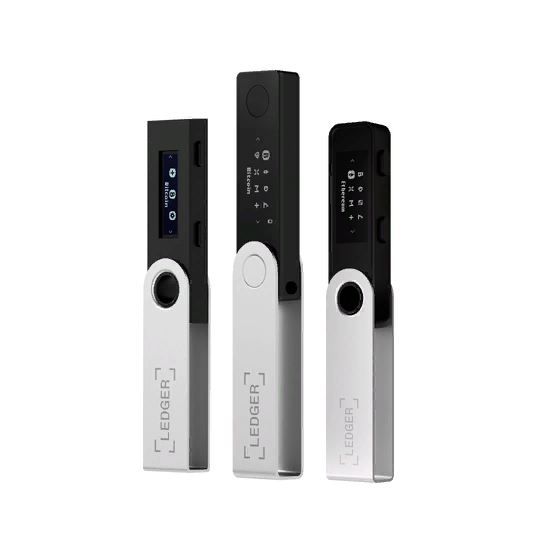
One of the most well-known hardware wallet brands on the market. They offer a variety of wallets, including the popular Ledger Nano S and the newer Ledger Nano X. These wallets are small, portable, and easy to use, making them an excellent option for both beginners and experienced investors. The Ledger wallets are also compatible with a wide range of cryptocurrencies, so investors can easily store their digital assets and Kaspa in one place: https://www.ledger.com/
Tangem

A relatively new player in the hardware wallet space. Yet, they have quickly gained popularity for their innovative approach and technology. Tangem wallets are actually physical cards that can be carried in a wallet or pocket. Each card has a chip that stores the private key for the investor’s digital assets. The Tangem cards are also easy to use, as investors simply tap the card against their phone to access their funds. This simplicity, combined with Tangem’s high level of security, has made them a popular choice for investors looking for an easy-to-use yet secure hardware wallet. 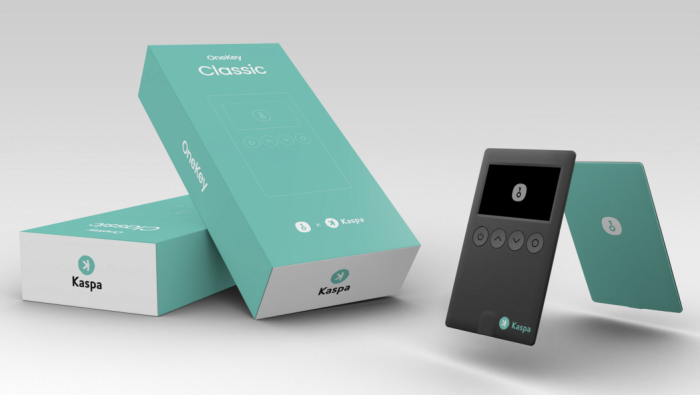
Kaspa Branded OneKey Classic
OneKey
Another hardware wallet brand with a strong following in the cryptocurrency community. Offering various products, including the OneKey Mini, OneKey Classic, and OneKey Touch. OneKey wallets are known for their exceptional security features, open-source code, and use of the OneKey App independent of hardware. These features make it extremely difficult for hackers to access an investor’s digital assets, even if they manage to get their hands on the physical wallet. OneKey wallets are also user-friendly, with a sleek and intuitive design that makes it easy for investors to manage their digital assets.
For many reasons, investors are recommended to use a hardware wallet like Ledger, Tangem, or OneKey. These wallets offer a higher standard of security by keeping the private key to the investor’s digital assets offline, which makes them less susceptible to hacks and cyberattacks. Ledger, Tangem, and OneKey are three of the market’s most popular and well-regarded hardware wallet brands, each offering unique features and advantages. All three provide a high level of security and ease of use for investors.
Direct link to pre-order for Kaspa.
Tip: Never use a pre-initialized hardware wallet; doing so could jeopardize the security of your crypto assets, making it possible for attackers to take control and withdraw your funds.
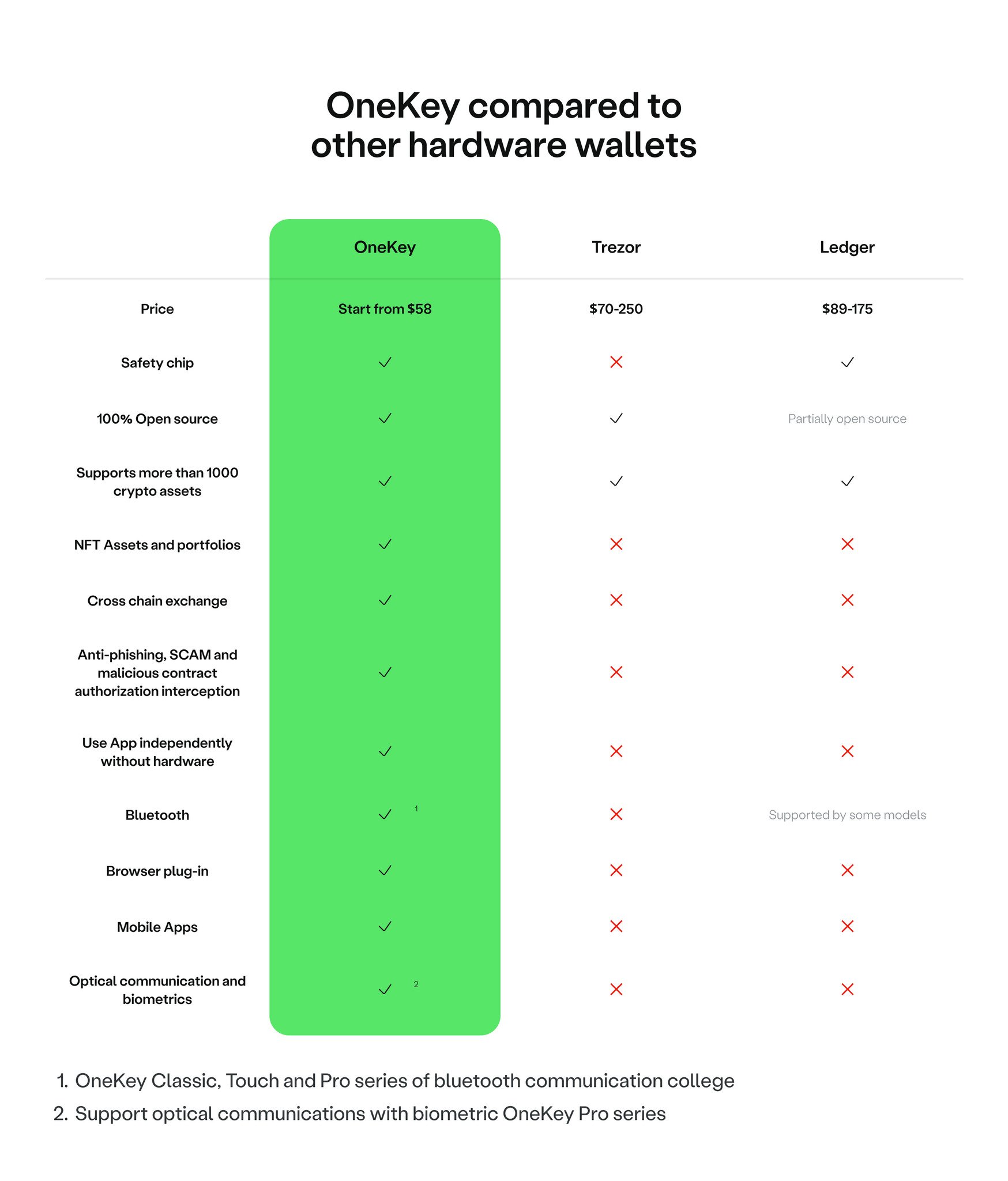
Kaspa’s Wallet Introduction
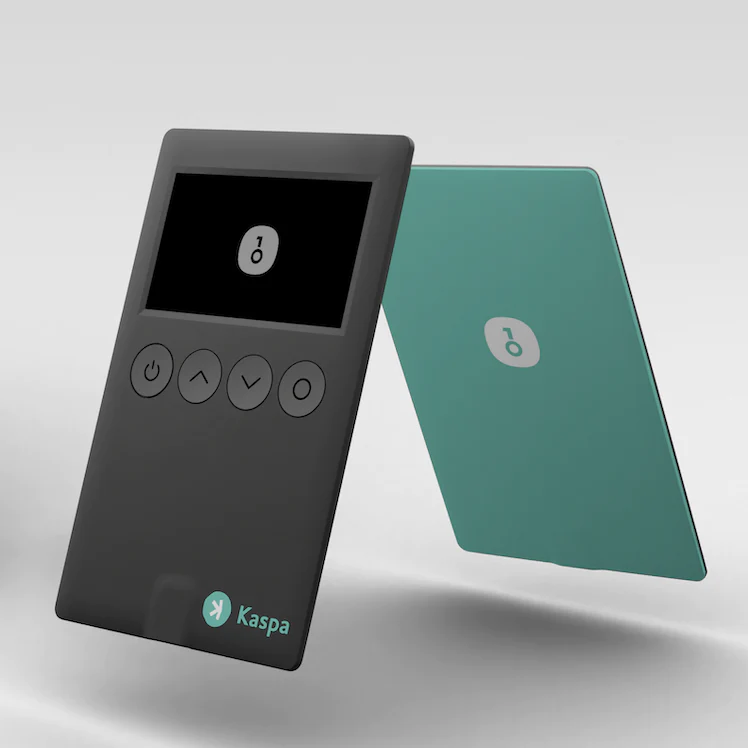
Presale OneKey x Kaspa -Crypto Hardware Wallet
Regular price: $89.00 USD
Kaspa is an open-source community-based project built on proof-of-work (PoW) consensus protocol. Founded in 2016 by Yonatan Sompolinsky at Harvard University, the project has no central governance or business model but instead relies entirely on its community. Kaspa uses blockDAG to resolve the scaling constraints present in most PoW networks such as Bitcoin. This is why it offers a tool to design layer 2 applications with better security and faster block processing speed. Kaspa Wallet is a product of DAGLabs, a research and development (R&D) firm with funding from PolyChain. As has been stated, Kaspa is a community project and hence does not have centralized control.
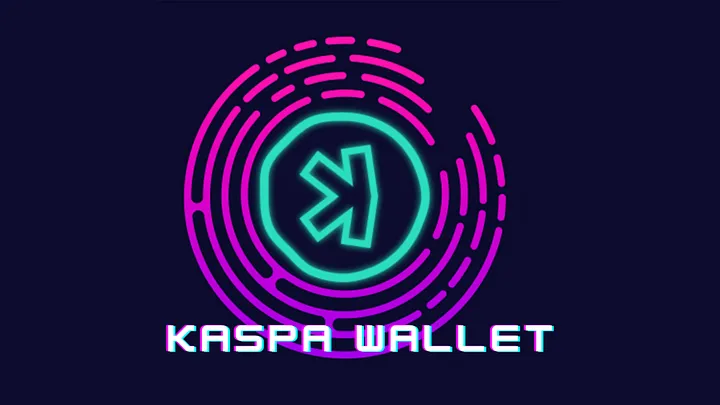
Kaspa wallet is known for its user-friendliness, reliability, and high-level security features. The wallet has been built on the Bitcore platform with many lines of security such as 2-factor authentication, multi-sig support, and hardware wallet support to support digital assets stored in it. The wallet is also applauded for its smooth user interface, which makes it easy to use with a technical team that is ready to help whenever called upon. This is one of the wallet’s distinctive features that makes it easy for anyone to receive and send cryptocurrency, which is a great feature for newbies in the crypto space who would want to interact with any supported cryptocurrency. Still, Kaspa does not miss the sophistication of a full-fledged wallet that allows users to manage transactions and monitor their digital assets.
1. Kaspa wallet types
Kaspa wallet has been designed for everyone in the crypto space, from newbies to experienced crypto users. As such, the wallet comes in 3 types:
- Kaspa web wallet
- Kaspa desktop wallet
- Kaspa Command Line Wallet
In this review, we will focus on how to use the Kaspa web wallet, which is the most common and easiest to access by everyone.
2. How to use Kaspa Wallet
The first thing to note about the web-based version of Kaspa Wallet is that it is available on Mac, Windows, Android, and iOS.
i) How to access Kaspa WalletTo set up a Kaspa wallet, you will need to access it first. To access the wallet, you can click on this link: Kaspa Wallet and you’ll land on a page looking similar to the image displayed below:

On the page displayed above, you can see two options to choose from when setting up your wallet:
- Create New Wallet: This is for you if you’re a new user who wants to start using Kaspa Wallet.
- Recover from Seed: This is for you if you had already created a new wallet but want to retrieve it plus the funds through the 12-word backup seed phrase.
ii) How to create Kaspa WalletAs a first-time user, you will need to choose the “Create New Wallet” option. When you click on the Create New Wallet option, you will be directed to a page that appears exactly like the image below:
As you can see, you will be required to set up your wallet’s password. Once you set up and confirm your password., you’ll be shown the 12-word backup phrase, from where you will be asked to verify some of the key phrases. I created a dummy account to illustrate the confirmation process.

After the successful verification, you can see my wallet’s landing page below:
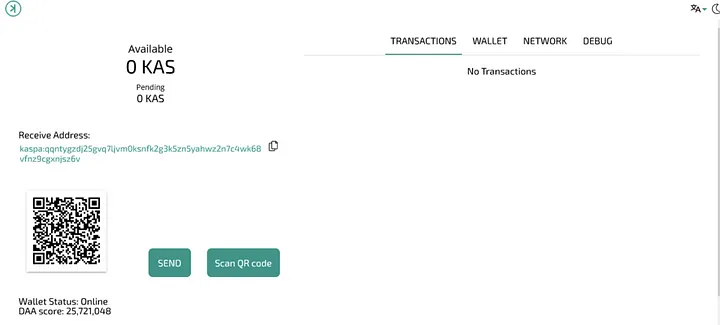
Important Note: Ensure your backup phrase is stored safely because losing it or giving it to a third party will put your funds at risk. Anyone can access your funds if they can access your backup phrase. Furthermore, it’s all you need to set up your account on any device.
iii) How to receive funds using a Kaspa Wallet
On the screenshot of my account landing page, you can see the “Receive Address” link, which I can copy and share with the source of my funds. There is also the QR code option for the address. You have the option to use this address or scan the QR code to get a KAS token from the exchange or any other Kaspa wallet.
iv) How to send funds using a Kaspa Wallet
Sending funds from a Kaspa wallet is quite simple. To send funds to another Kaspa wallet, click the send button, which will give you the following page to fill up:
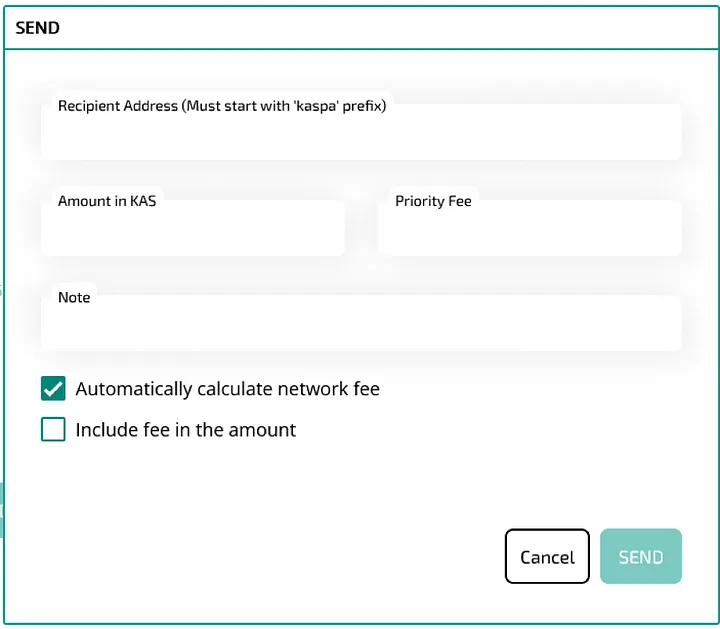
As you can see, you need to provide the recipient’s address, the amount you will send, and a note (optional).
You can also set the priority fee for the transaction as indicated above, then confirm your transaction.
How to view transactions in the wallet.
3. Kaspa Wallet’s Features
Kaspa wallet has numerous features that set it apart from other wallets.

- User-friendly interface- this allows even new users to get started with little support.
- Auto-compound wallet feature that allows for the auto-transactions option
- Backup Seed phrase: you can check your seed phrase by giving your password in this section.
- Recover from Seed: this is available in case you need to recover your wallet and funds. You can back up your seed phrase before you import some other account. To import your account, you’ll be prompted to enter the correct 12-word backup phrase.
- Export Wallet Seed File (KPK) option- this option will allow you to export the seed file of your current Kaspa wallet.
- Import Wallet Seed File (KPK)- You can use this option to import the seed file of your Kaspa wallet to import the account. You will have the option to search for your seed file on your local drive.
4. How to receive free KAS Tokens from Faucet
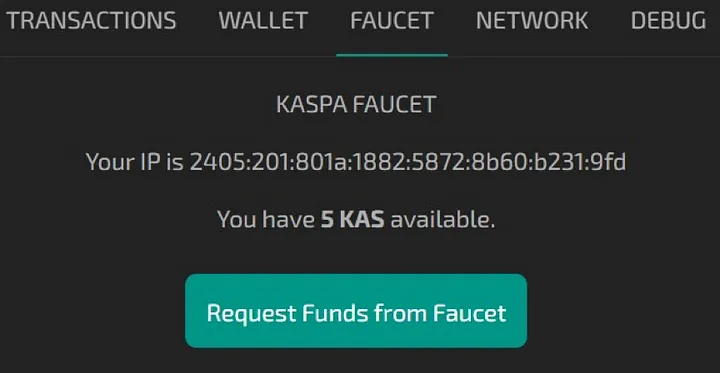
From your account, you can request funds from FAUCET as illustrated in the screenshot above. From the FAUCET tab, you can request some free KAS tokens by clicking on the “Request Funds from Faucet” button. Once you confirm the process, your KAS token balance will be displayed in your account as shown in the image above. The request is allowed only once per day (24 hours).
5. Kaspa’s Network
Kaspa network is illustrated through its mainnet in the below screenshot. The PoW-based ledger organization in a DAG of blocks, blockDAG.

Conclusion
Kaspa wallet is one of the fastest-growing crypto wallets in the market. The wallet simplifies the online purchase of goods and services without worries about fluctuating exchange rates or taxes. You can simply input the desired amount by clicking the pay button, then enter the address of your recipient. The funds will be automatically converted into the crypto of your choice. The wallet is also lauded for its high safety standards and smooth user interface.
With the growing adoption of cryptocurrencies, hardware wallets are becoming more and more important. Hardware wallets are more secure than the other alternatives because they’re very hard to hack. They allow users to store their private keys offline, which reduces the risk of them being compromised.
Such wallets can also be used to sign transactions offline, which further increases security.
OneKey is a decentralized multi-chain cryptocurrency hardware wallet that is used to secure, buy and exchange digital assets. The open source wallet manufacturer further claims that it uses industry-leading encryption algorithms to ensure that each user’s assets are completely secure.
OneKey has a diversified product line, including OneKey Swap, Onekey desktop, Onekey Plugin, and Onekey App. OneKey hardware wallet supports BTC, ETH, OKT, BSC, HECO and other networks, compatible with OneKey plugin and Metamask to connect hardware wallets to participate in DeFi, it is the necessary hardware wallet for users to participate in DeFi.
"OneKey is, to date, the only hardware wallet in the world that is 100% open source and uses a certified secure chip," Yishi Wang, core contributor at OneKey.
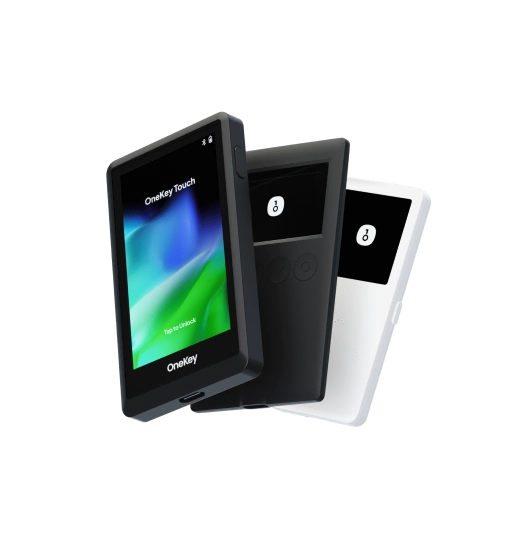
1. OneKey Products
1.1. Hardware Wallets
- OneKey Mini
- OneKey Classic
- OneKey Touch
- OneKey x Kaspa -Crypto Hardware Wallet
- OneKey Lite (Recovery Phrase Backup Card)
- OneKey KeyTag (Seed Phrase Storage Kit)
1.2. App
- Desktop App
- Mobile App
- Browser Extension
- Hardware Bridge
- Web
2. High-quality products
OneKey provides best-in-class security for encrypted assets without compromising accessibility and day-to-day operations.
- CE and RoHS Certification
Its internal high-quality random number generator satisfies NIST SP 800-90A/B/C.
- Ultrasonic Welding Process
There is no way that someone could secretly tamper with your hardware wallet without you noticing.
- EAL6 Certification
For now, some of the OneKey products have received EAL6 Certification.
3. Security
OneKey provides best-in-class security for encrypted assets without compromising accessibility and day-to-day operations.
- Open source
- Secure element
Currently, some hardware wallets store the most valuable private keys directly in the microprocessor (MCU), which is quite terrible. In contrast, OneKey uses a Secure Element—the ATECC608A from Microchip, to be exact— to protect your crypto assets. With the help of the exquisitely designed SHA-256 response control, OneKey can effectively prevent replay and eavesdropping attacks.
- Keep private keys offline
OneKey do not store your private key in your device microprocessor (MCU), but in a separate security chip ATECC608A.
Therefore, no matter how you use your OneKey hardware wallet, your private key will never touch the internet from start to finish.
To be precise, OneKey helps you confirm and authorize every on-chain transaction, with the signing process done on your device, instead of your PC or smartphone. Also hardware wallets are able to parse original transaction information, which means the common cryptocurrency scams don't work on hardware wallets as disguise will be uncovered before you sign the transaction. It prevents you from scams and keep your assets safe.
Compare OneKey
crypto hardware wallets
Which is the right one for you?
4. Advantages of OneKey Hardware Wallet
- Open source firmware code - OneKey use both a secure chip (SE) and a universal chip for our hardware wallets. Again, everything from 3D source files to PCB circuit boards and, most importantly, firmware source code can be found in our code repository.
- Open source software code - If a wallet doesn't open source its code, you're likely to worry that it's hiding a backdoor that could compromise the security of your assets. Our code is fully publicly hosted on Github, so anyone can inspect or use our code. https://github.com/OneKeyHQ/OneKey-Wallet
- Private Keys Under Your Control - Wallet helpers and seeds created through OneKey are encrypted and stored locally so that only you can decrypt the information and our servers do not and cannot store any of the user's private data. There are no more centralized institutions involved and you are in full control of your crypto assets.
- Privacy is a top priority - You can change the node, server, block browser, and preferences locally in the App. OneKey's servers do not store any private data about users and do not covet their personal information.
- No Bluetooth Requires USB Type-C connection for use.
- Easy to use for beginners
- Perfectly adapted to wallets such as MetaMask, DeFi mining and collecting vegetables are both suitable. No secondary sales, all returned goods are destroyed.
5. Advanced on-chain wallet App
OneKey is the smartest way to secure, buy, exchange and grow your crypto assets.
Use OneKey App separately to store and use your crypto assets in a secure and convenient manner. Each user’s assets are appropriately secured and stored locally.
What makes OneKey different?
Over the past few years, OneKey's Team been refining a unique set of tools and methods to radically reduce complexity and make managing encrypted assets for individuals and teams easier rather than a chore. OneKey has been refined and stress tested by nearly a million users and is the gold standard for simpler, better crypto asset management.
- OneKey is a decentralized multi-chain cryptocurrency hardware wallet that is used to secure, buy and exchange digital assets. The open source wallet manufacturer further claims that it uses industry-leading encryption algorithms to ensure that each user’s assets are completely secure.
- OneKey is the easiest solution for keeping crypto assets and NFTs, trading, and tracking account dynamics. Instead of managing various assets on various decentralized platforms, you’ll have a one-stop solution for all your crypto asset management needs here.
- OneKey is deliberately designed to keep things simple. That’s why sometimes users who leave in search of “more features” end up coming back because other wallets are too complex, and are firmly committed to using our wallets ever since.
- Top-notch crypto investors, individual users of giant whales, exchanges, internet companies, institutional investors...
- Nearly a million users from 166 countries on five continents are using OneKey, and we have users from every walks of life.
- Ditch frustrating and inefficient decentralization and take security and efficiency to the next level with OneKey's one-stop solution.
Learn more about the best TOP 30 hardware cryptocurrency wallets
You can see this list here.
TOP 29 Hardware Wallets, the Official Online Stores
| 1 |  | Trezor hardware wallet, the official online store |  |
| 2 |  | Ledger hardware wallet, the official online store |  |
| 3 |  | KeepKey hardware wallet, the official online store |  |
| 4 |  | BitBox02 hardware wallet, the official online store |  |
| 5 |  | CoolWallet hardware wallet, the official online store |  |
| 6 |  | ELLIPAL hardware wallet, the official online store |  |
| 7 |  | D'CENT hardware wallet, the official online store. |  |
| 8 |  | SafePal hardware wallet, the official online store |  |
| 9 |  | SecuX hardware wallet, the official online store |  |
| 10 |  | BC Vault hardware wallet, the official online store |  |
| 11 | 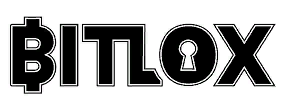 | BitLox hardware wallet, the official online store |  |
| 12 |  | Keystone hardware wallet, the official online store |  |
| 13 |  | ProKey hardware wallet, the official online store |  |
| 14 |  | NGRAVE hardware wallet, the official online store |  |
| 15 | 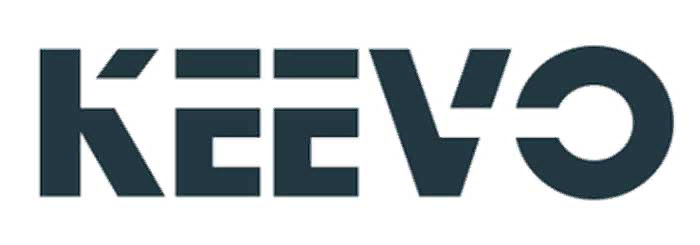 | Keevo hardware wallet, the official online store |  |
| 16 | 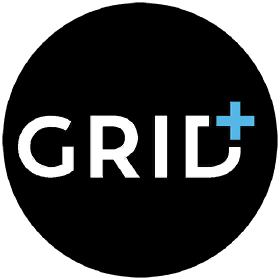 | GridPlus hardware wallet, the official online store |  |
| 17 |  | Ballet hardware wallet, the official online store |  |
| 18 | 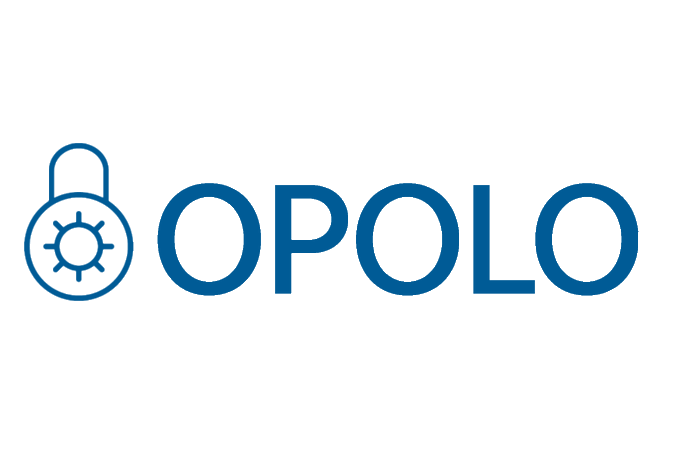 | OPOLO hardware wallet, the official online store |  |
| 19 |  | Foundation (Passport) hardware wallet, the official online store |  |
| 20 |  | ImKey hardware wallet, the official online store |  |
| 21 |  | Tangem hardware wallet, the official online store |  |
| 22 |  | HashWallet hardware wallet, the official online store |  |
| 23 |  | Material Bitcoin hardware wallet, the official online store |  |
| 24 |  | ShieldFolio hardware wallet, the official online store |  |
| 25 |  | OneKey hardware wallet, the official online store |  |
| 26 |  | Blockstream Jade hardware wallet, the official online store |  |
| 27 |  | Cypherock hardware wallet, the official online store |  |
| 28 |  | Keepser hardware wallet, the official online store |  |
| 29 | 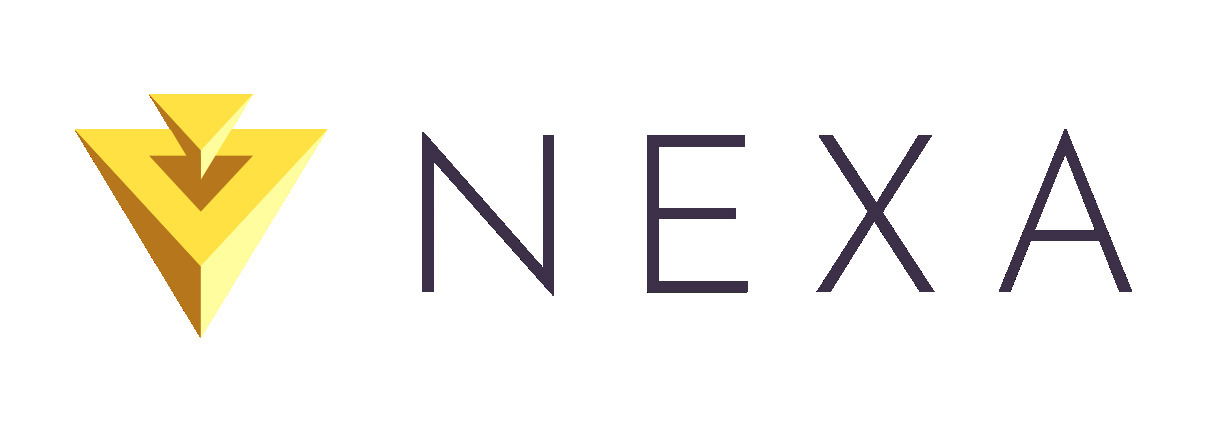 | NEXA hardware wallet, the official online store |  |
TOP 20 Best Metal Cold Storage Seed Phrase Backups, the Official Online Stores
Disclaimer: It is essential to conduct thorough research on investments. The same goes for the hardware options being developed to support Kaspa. Please note that these hardware wallets are not affiliated with Kaspa.

